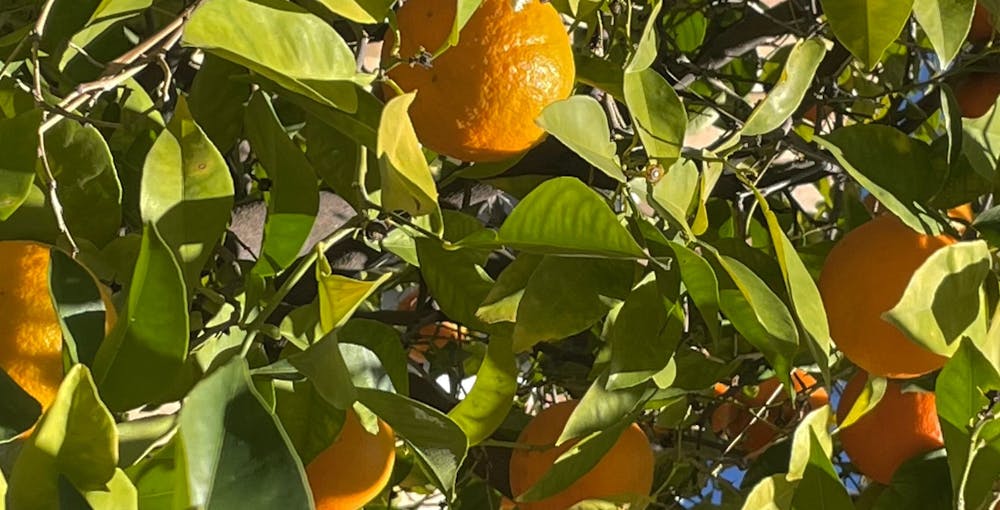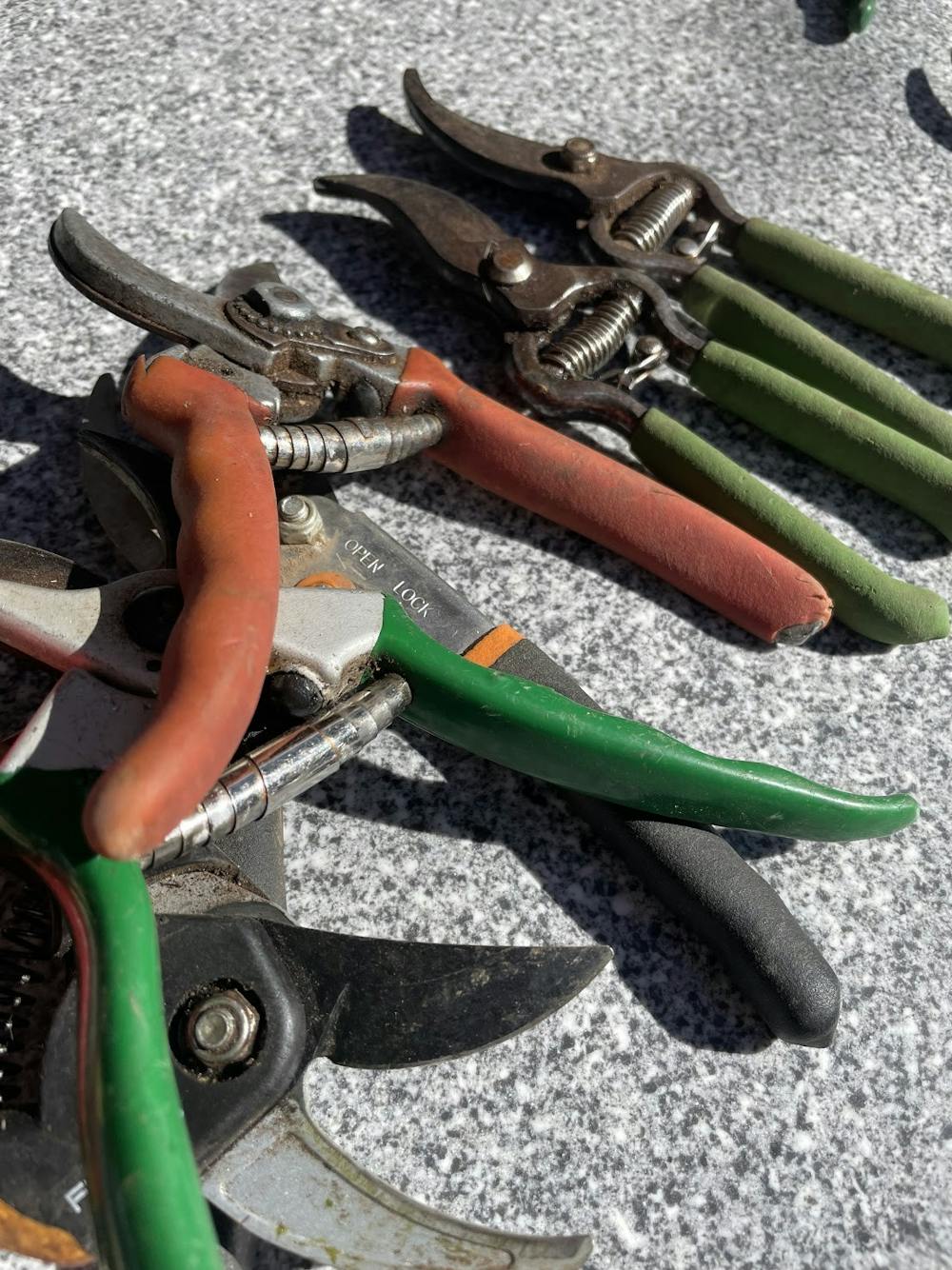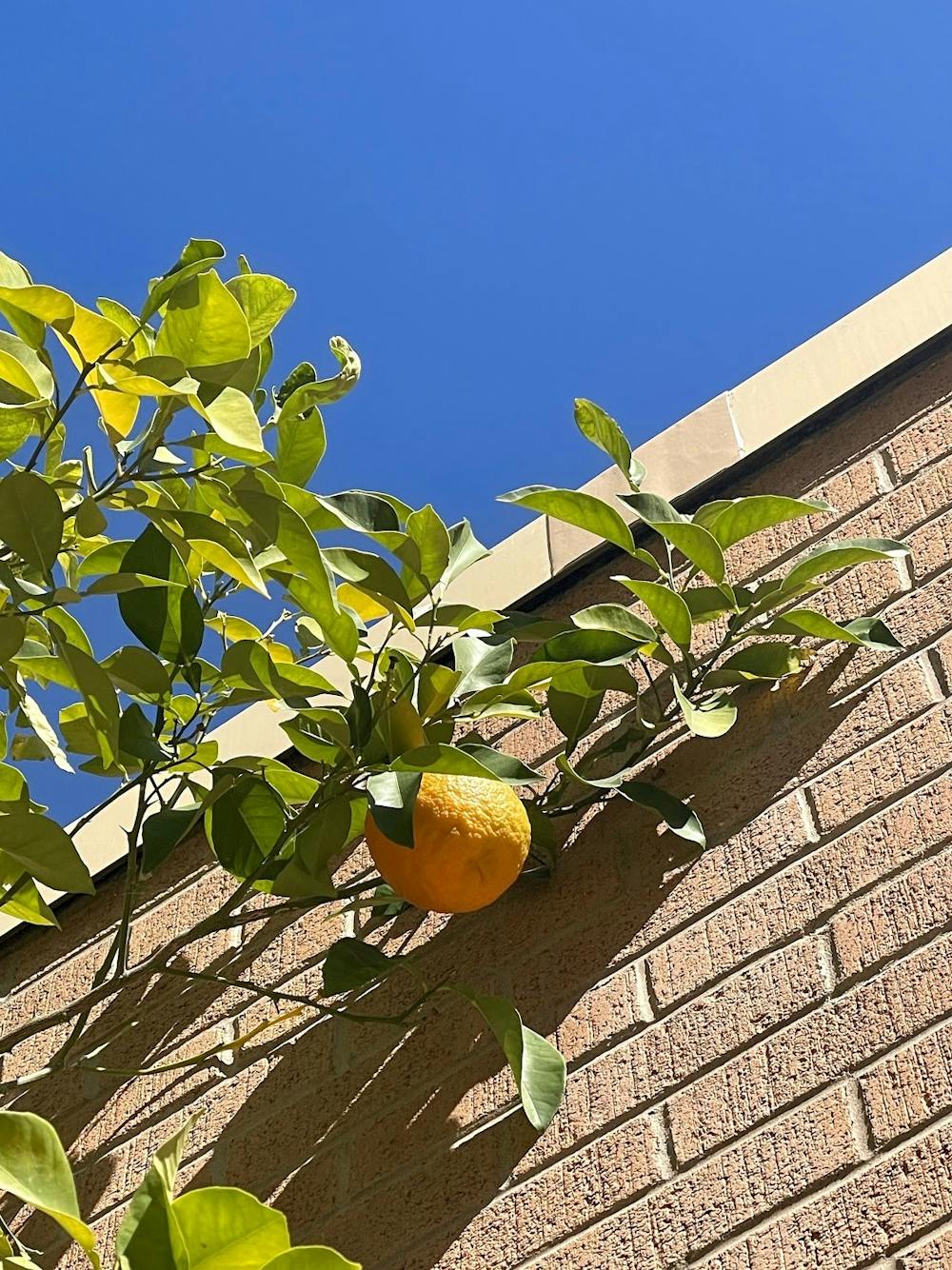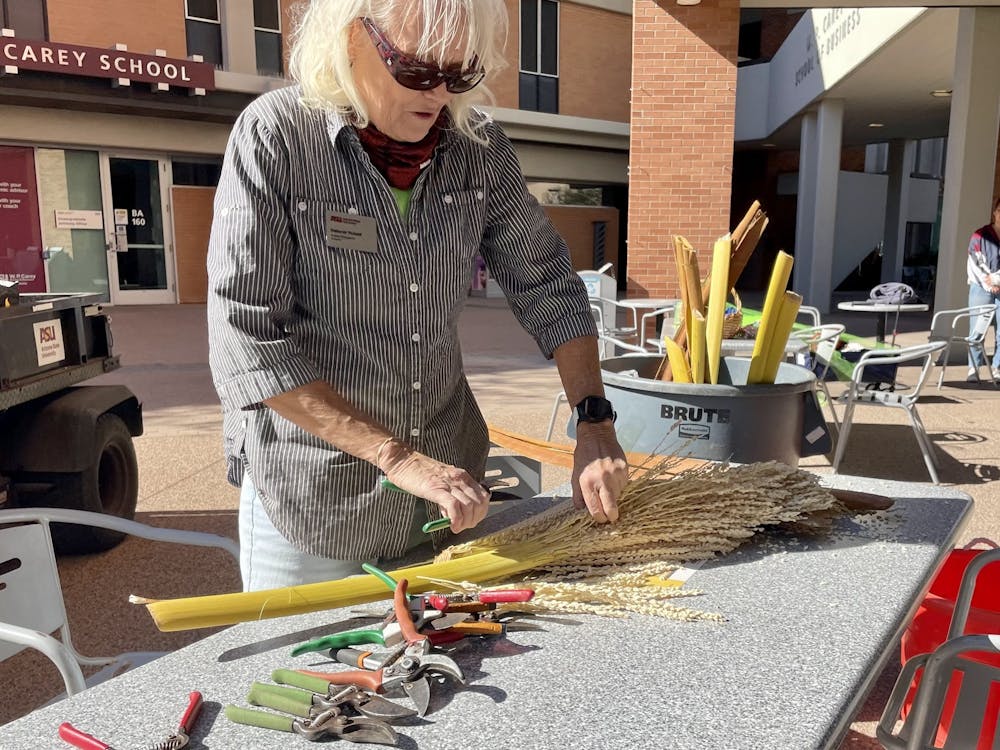Springtime on ASU's Tempe campus is characterized by the bright Seville sour oranges blooming overhead. Everywhere you look — a round juicy orange peers back at you. Before the oranges hit the ground, hordes of volunteers gather to harvest them all, knowing the sour oranges will return again next year as they have every year since 2008.
However, the aroma of citrus has diminished on campus.
ASU campus harvests have been putting campus-grown produce back into the food supply for decades, but in the wake of climate change, the water crisis and the pandemic, the harvests have had to adapt to change.
Deborah Thirkhill, grounds services program coordinator, is facing these issues head-on. She was hired to coordinate the first sour orange harvest over a decade ago and is the primary point of contact when it comes to cultivating, harvesting and producing.
Thirkhill said the University once had over 250 sour orange trees, which made it easy for her and the volunteers to produce the 10,000 pounds of oranges needed for cleaning and juicing at Sun Orchard Juicery.
But as the University expanded, construction continually left chopped-down trees in its wake. In August 2021, the water shortage in the Colorado River compelled the University to get rid of its orange trees.
"ASU Sustainability wants us to lower our water usage on campus and plant more native plants," Thirkhill said.
She added that food producing plants require more water than native plants, and the campus landscape is going for a more geographically accurate look that resembles the surrounding desert landscape.
"You're saving water, but you've just wiped out a unique part of ASU that can't be replaced," Thirkhill said. "The oil and the fragrance of those oranges are gone. ASU needs to make a decision as a community on what they want the campus to look like. You can't have both."
The University is heavily involved in water conservation projects like aeroponics — the process of growing plants in an air or mist environment without the use of soil — and the initiative to automate watering systems based on weather and varying evapotranspiration rates. But there are pros and cons.
"You can get a lot of food from aeroponic towers, but your plant has no contact with the soil and it's not organic because it's all chemical," Thirkhill said. "But you can produce a lot of food in a small area (by shifting) the agriculture away from soil based to aeroponics. You have to decide which way you want to go."
In Tucson, University of Arizona faced similar issues, resulting in handing the campus harvests off from their Campus Arboretum to their School of Sustainability.
Tanya Quist, director of UA's Campus Arboretum, explained their campus harvests began with faculty members from the Arboretum wanting to save fruit from falling to the ground and going to waste.
"You have to balance the inputs and the outputs," Quist said. "If we put energy into planting, growing, caring for and watering trees, you have to be sure that you’re getting as much of the benefits or the outputs as possible. One of those, of course, is the fruit."
However, in 2015, the UA Campus Arboretum could no longer be involved with the campus harvests. Quist said the timing wasn't ideal for larger operational support and funding from the university.
Before 2015, UA faculty members were expected to go beyond their job descriptions and had to raise money, organize, mentor and pay student volunteers all while coordinating the campus operations.
Being an academic unit, separate from facilities management and ground services, the faculty found the resources and priorities between the two sects of the university didn’t align. The campus harvests evolved into a huge undertaking. Eventually, the inputs weren't equalling the outputs.
"We live in a desert and … we have a very large urban population in the desert — that combination just screams at the opportunity to make sure that every drop of water, every ounce of effort that we put into building urban green spaces, is utilized for someone's benefit," Quist said.
She also emphasized the need to remember that trees are not wasting water; they're recycling and recirculating it. In the meantime, trees provide an array of benefits fundamental to the health of both people and the planet.
"If you're withdrawing more from your bank account than you're putting in, eventually you're not in a financially sustainable situation," Quist said. "That's how I think of our urban landscape."
Past pollination
There were only a handful of college gardens in '80s and '90s America. Around 2005, the idea of providing opportunities for students to give back to the land across American universities started growing in popularity.
ASU has been harvesting and selling dates since the '80s to reduce the amount of waste the trees produce and distribute dates into the community.
Unlike the sour orange harvest, the date harvest is expected to continue this fall. The dates are prepared and packaged by volunteers and sold to the Tempe community.
At times when Thirkhill has excessive bags of dates, she sells them at Tempe farmers markets and hands them out at city events.
The revenue from selling dates goes right back into the program — for purchasing harvesting supplies, date trays and packaging — and into facilities management, which takes care of the landscape.
But due to the pandemic, Thirkhill said the dates are now processed at Sphinx Date Company.
The pandemic also shut down what was going to be the last sour orange harvest of 2020.
"We were all waiting to see if ASU would close, and sure enough, the night before the harvest, they closed down," Thirkhill said. "The poor alumni got stuck with a few hundred bagels because they always provided a nice breakfast for everybody who showed up."
Tempe campus still produces a variety of fruit. Variations of dates, jujubes and the remaining oranges and peaches are casually picked when ripe. Thirkhill uses these plants as opportunities to teach her gardening class or the gardening club.
"We net the peaches to keep the birds from poking holes in them or people walking by from pulling the peaches off," she said. "When they finally ripen — which is usually around April or May — I try to get the students first pick. There’s nothing like biting into a peach and having the sweet juices flow down your chin."
Evidently, the ASU community has been able to reap what the campus harvests have sowed.
Education and community
Thirkhill said the connection with growing and preparing food has been lost. Her goal is to encourage people to recognize food can be in your own backyard.
"For example, there's olive trees all over the valley — like in people's front yards — and the olives just drop to the ground," she said. "I've taught my class and the gardening club how to pick the campus olives and grind them. Then they donate it out to anybody who might need a jar of olives."
Thirkhill highlights the importance of reclaiming personal connection with food and using produce to combat food insecurity. Anytime she has enough produce from the harvests, she shares it with Pitchfork Pantry.
"You're creating a culture for the next generation," she added.
Campus harvests also serve as opportunities for ASU to garner a sense of community.
Christine Wilkinson, ASU's senior vice president and president of the Alumni Association, said the association has been bringing in volunteers to the sour orange harvest for years. One year they brought around 140 volunteers. The Alumni Association connects ASU alumni to volunteer projects all over America, but there's something about the campus harvests that keeps big groups of alumni coming back.
Wilkinson remembered one year, a former ASU graduate became a teacher in the West Valley and brought a busload of her students to help with the harvest. Alumni also bring their families, and as the oranges drop to the ground, children help pick them up.
Patricia Thiele-Keating, Alumni Association director, brought her girls to the harvests every year since they were toddlers. Now, her family considers them a tradition.
Even though the sour orange harvest is history, its reputation has opened doors for Thirkhill and volunteers to help save other oranges. Kaser Citrus, a commercial grove in Mesa, reached out to Thirkhill asking if she would like to harvest Valencia oranges so they would not go to waste.
Every Saturday in March, students, alumni, staff and volunteers plan to harvest sweet oranges from the 18-acre grove. Unlike ASU's sour oranges, food banks will take Valencias. Wilkinson said they hope to bring oranges back to ASU-sponsored food pantries.
Students can sign up for campus harvests through Changemaker Central at ASU, but in the past, Thirkhill had student volunteers from Key Club, on-campus service groups and other organizations.
A budding future
On Feb. 6, students from various religious and cultural backgrounds congregated by the Spirit horse statue in front of the W. P. Carey building to help Thirkhill.
Thirkhill needed volunteers to create pollen balls to hand-fertilize the dates, and Suzy Stone, senior Jewish educator at ASU Hillel, was looking for volunteer opportunities for students on Sundays because of Shabbat on Saturdays. The two collaborated and connected the students with the dates by explaining the significance date palms have in different cultures.
Students shook the date palm flowers off the palm and wrapped the pellet-sized flowers into a netted ball. When the flowers dry, the balls are thrown up into the date palms on Palm Walk, creating clouds of pollen to pollinate the trees.
"For myself included, I didn't even really understand that date palms needed to be hand fertilized," Stone said. "A lot of times we're so removed from our food system, so that was a big inspiration for me — to help us reconnect to our food system."
Even though the smell of citrus no longer tickles the noses of passersby, and the future of harvests aren't looking as bright as the Seville sour oranges, campus harvests have still found a way to remain true to the environment, the community and the history of ASU.
"This was an opportunity for students to really get their hands dirty," Stone said. "To really understand how our campus is a living and breathing campus."
Reach the reporter at savannah.dagupion@gmail.com and follow @savdagupion on Twitter.
Like State Press Magazine on Facebook and follow @statepressmag on Twitter and Instagram.
Continue supporting student journalism and donate to The State Press today.

Savannah is a senior studying journalism with a minor in English. This is her eighth semester with The State Press. She has also worked at the Lonely Planet and Write On Downtown.







